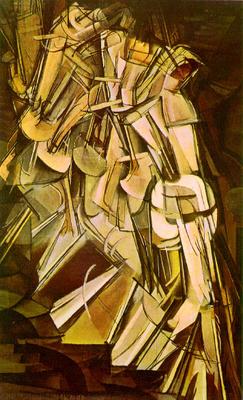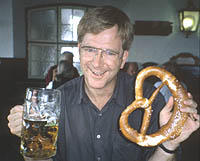Yes, but is it Art?
 Although this week’s readings captured my attention more than other theories we’ve read this semester, I have a few problems I’d like to point out. First, why is beauty and pleasure the chief function of art? Although I like pleasant looking still pictures, with beautiful colors and images, it is only a fraction of what art can do. Take Marcel Duchamp, for example. In reading Lessing, I couldn’t help but notice Lessing’s archaic ideas dealing with the plastic arts. Lessing says that painting fleshes out a single moment because a picture is unable to illustrate chronology as poetry does. Duchamp’s “Nude Descending a Staircase, No. 2” renders this idea obsolete.
Although this week’s readings captured my attention more than other theories we’ve read this semester, I have a few problems I’d like to point out. First, why is beauty and pleasure the chief function of art? Although I like pleasant looking still pictures, with beautiful colors and images, it is only a fraction of what art can do. Take Marcel Duchamp, for example. In reading Lessing, I couldn’t help but notice Lessing’s archaic ideas dealing with the plastic arts. Lessing says that painting fleshes out a single moment because a picture is unable to illustrate chronology as poetry does. Duchamp’s “Nude Descending a Staircase, No. 2” renders this idea obsolete.  Clearly there’s a chronological movement in this painting. Although it may be the illusion of movement, it is an artistic manipulation of scene that is in keeping with the artist’s sculpting of Laocoon’s face. Working further with Duchamp, the idea that art’s chief function is to render beauty that induces pleasure in the spectator is also broken. This can be seen in Duchamp’s use of readymades. The best example of this is his sculpture “Fountain,” which is a signed urinal, placed in a gallery.
Clearly there’s a chronological movement in this painting. Although it may be the illusion of movement, it is an artistic manipulation of scene that is in keeping with the artist’s sculpting of Laocoon’s face. Working further with Duchamp, the idea that art’s chief function is to render beauty that induces pleasure in the spectator is also broken. This can be seen in Duchamp’s use of readymades. The best example of this is his sculpture “Fountain,” which is a signed urinal, placed in a gallery.  This conceptual art can be seen as an example of what Bourdieu would call cultural capital. [“These rich folk are nuts!” a person of the lower class may say. “Did you see what’s in the art gallery? A urinal, a bike wheel, and a text book!”] I would disagree with this assertion, however, as I see Duchamp’s use of readymades as a challenge to the elitist view of art—the artistic concept being to provoke the art establishment’s idea of cultural commerce. However, with this contemporary era of conceptual art, I am beginning to ponder the question of whether art even exists. In visiting the Tate Modern Gallery in London a few years back, I was intrigued by a piece called “An Oak Tree,” which is a glass of water on a glass shelf.
This conceptual art can be seen as an example of what Bourdieu would call cultural capital. [“These rich folk are nuts!” a person of the lower class may say. “Did you see what’s in the art gallery? A urinal, a bike wheel, and a text book!”] I would disagree with this assertion, however, as I see Duchamp’s use of readymades as a challenge to the elitist view of art—the artistic concept being to provoke the art establishment’s idea of cultural commerce. However, with this contemporary era of conceptual art, I am beginning to ponder the question of whether art even exists. In visiting the Tate Modern Gallery in London a few years back, I was intrigued by a piece called “An Oak Tree,” which is a glass of water on a glass shelf. 
Upon seeing this, I thought, “Well I’ll be goddamned! A glass of water on a shelf called Oak Tree. That’s brilliant!” Although I disagree with Bourdieu in his assertion that the idea of high art is a codified system illustrating class difference (my group’s task was to support his ideas), I can see how his ideas work in certain situations (but not always, which is the reason I disagree with him). The excesses of conceptual art act in this way. This is cleverly illustrated in the popular art medium of the Britcom. In Absolutely Fabulous (written brilliantly by Jennifer Saunders), Edina Monsoon, a wealthy socialite,  purchases a number of modern art sculptures that she acquires to display wealth. In showing this art to her friend Patsy, Edina comes across the casket of her dead father, for which there is a memorial service in her house later that afternoon. “This is a, sort of…this is a corpse in an oaken…oaken oblong coffin. It’s a dead body, Pats.” To which Patsy replies, “Yes, but is it art, Eddie?”
purchases a number of modern art sculptures that she acquires to display wealth. In showing this art to her friend Patsy, Edina comes across the casket of her dead father, for which there is a memorial service in her house later that afternoon. “This is a, sort of…this is a corpse in an oaken…oaken oblong coffin. It’s a dead body, Pats.” To which Patsy replies, “Yes, but is it art, Eddie?”










